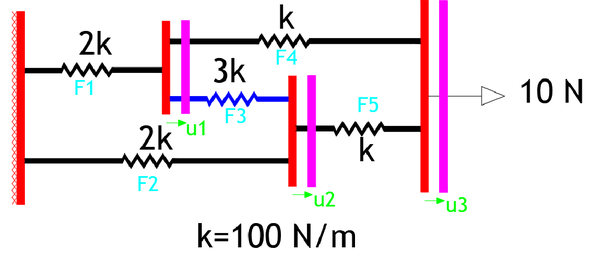Spring force
What is the force (in Newton) in the blue spring?
Assumptions:
- The red connectors are rigid and do not rotate. They can only be shifted horizontally.
- The red connector on the far left is attached to a wall.
The answer is 0.
This section requires Javascript.
You are seeing this because something didn't load right. We suggest you, (a) try
refreshing the page, (b) enabling javascript if it is disabled on your browser and,
finally, (c)
loading the
non-javascript version of this page
. We're sorry about the hassle.
2 solutions

Let magenta lines be the connector's final position.
Also, let F 1 , F 2 , F 3 , F 4 , F 5 and u 1 , u 2 , u 3 be the displacements of connectors and spring forces, respectively.
Now, we can write each force wrt. displacements and spring constants.
F 1 = u 1 × 2 k F 2 = u 2 × 2 k F 3 = ( u 2 − u 1 ) × 3 k F 4 = ( u 3 − u 1 ) × k F 5 = ( u 3 − u 2 ) × k
List down the force equilibriums at each connector,
F 4 + F 5 = 1 0 N F 1 = F 3 + F 4 ⋯ ( 1 ) F 5 = F 3 + F 2 ⋯ ( 2 )
Rewrite ( 1 ) and ( 2 ) in the form of displacements and spring constants,
F 1 = F 3 + F 4 ⟹ k × 2 u 1 = k × ( 3 u 2 − 4 u 1 − u 3 ) ⋯ ( 3 ) F 5 = F 3 + F 2 ⟹ k × ( u 3 − u 2 ) = k × ( 5 u 2 − 3 u 1 ) ⋯ ( 4 )
From ( 3 ) and ( 4 ) we can figure out u 1 = u 2
Then the blue spring force F 3 = ( u 2 − u 1 ) × 3 k = 0
I did it without much calculations.
Just remove the 3k spring and both the spring systems (springs connected by the red connectors) turn out to be same thus facing same elongation .
Hence, same velocity.
Thus the relative velocity will be 0. So no elongation and no net force.